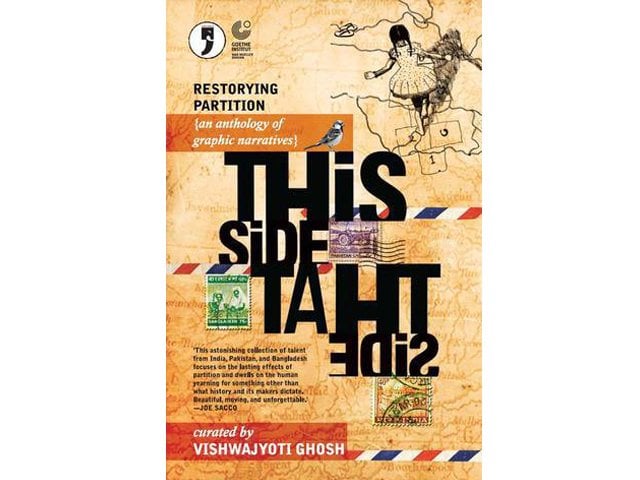
Writer Salman Rashid mesmerised the audience at Faiz Ghar on Thursday with his stories on the Indian subcontinent’s partition in 1947, during a session on his book This Side That Side. The book is an anthology of graphic narratives of partition from more than 40 contributors from India, Pakistan and Bangladesh.
With a back drop of projected black and white sketches from partition, Rashid narrated stories of his family’s sufferings during partition. He said during his visit to Jullundur in 2008, he came face to face with the son of the man responsible for killing his family members. Rashid narrated 74 year old Mahindra Pratap Sehgal’s description of communal tension in the city of Jullundur in 1947. Sehgal’s father had killed Rashid’s grandfather at this time. Rashid said he could not feel any anger or hatred against Singh, who had witnessed the events as a 13 year old boy.
“He wanted to speak about the events that unfolded during partition, particularly about the killing in my grandfather’s neighborhood. It was as if he wanted to shed his guilt, and perhaps even his father’s”, Rashid said.
Sehgal described in detail how Rashid’s family had gone into hiding and were eventually killed by their neighbours. Often calling his own father as ‘foolish’ and ‘cruel’, Sehgal described the brutal murder of Doctor Sahib - Rashid’s grandfather.
“Mahindra Pratap Sehgal was only 13 years of age when the partition took place. He probably didn’t approve of what his father did”, said Rashid. Rashid said that despite the bitter history, he and Sehgal had developed a bond. Rashid met him each of the three times he went to Jullundur.
“Partition is and probably will remain unsurpassed”, said lawyer and activist Ahmad Rafay Alam, moderating the session. He said the time was ripe for the youth on both sides to learn more and reflect about the Partition. Alam, along with Rashid, contributed to the graphic novel.
Alam narrated how his grand parents had come upon abandoned homes in the heart of Lahore when they arrived in Pakistan after the Partition.
For Indian graphic artist and curator of the graphic novel, Vishwajyoti Ghosh said “You hear many partition stories of violence or accounts of the life of an era past, but persuading people to work on a graphic novel is a greater challenge”. He said graphic novels were a market South Asia, and it was difficult to convince people to take it seriously. “People were surprised that a medium like a graphic novel would be used to address a serious issue like partition…it took a lot of convincing”, said Ghosh. Ghosh shared his experience of working with Bangladeshi contributors where the term ‘partition’ had more than one dimension. “For Bangladesh, it was not just about 1947 but also about 1971”, he added. He said this led to the inclusion of narratives from the events that unfolded in 1971.
The book encompasses 28 stories across the borders of India, Pakistan and Bangladesh. “The interesting part of collaboration is that you have to let your piece go, in someone else’s hand… but it was the common feeling between stories that helped connect the dots”, said Ghosh.
Ghosh will also be participating in the three-day Lahore Literature Festival, opening today (Friday).
Published in The Express Tribune, February 21st, 2014.






























1713853507-0/MalalaHilary-(2)1713853507-0-270x192.webp)







COMMENTS
Comments are moderated and generally will be posted if they are on-topic and not abusive.
For more information, please see our Comments FAQ